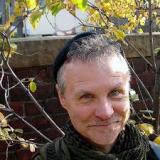Paganistan: Notes from the Secret Commonwealth
In Which One Midwest Man-in-Black Confers, Converses & Otherwise Hob-Nobs with his Fellow Hob-Men (& -Women) Concerning the Sundry Ways of the Famed but Ill-Starred Tribe of Witches.
What is the Symbol of Earth?
In Baltic lore, each of the Old Gods has his or her own sign.
For the Sun, it's the Sun Wheel. For the Moon, the Crescent.
Fire is the Fire Cross, the swastika, Thunder, the Thunder Cross, or compound swastika.
The Winds, since there are four of them, have the Cross, Heaven the Mountain. (How else would you draw a picture of the sky?)
But what about Earth?
My teacher, Tony Kelly, of the Pagan Movement in Britain and Ireland, used to say, “If we know anything at all about Earth, we know that she's Mother.”
At the time, as a good, doctrinaire second wave feminist, I found this statement reductionist and objectionable.
Since then, I've changed my mind.
Take a look at Earth's brothers and sisters, the other planets of our solar system. Then look at Earth. What's the difference?
So I think that Earth's symbol is the Wedge, the Delta.
Having independently reached this conclusion, I was pleased to find that Mary Mackey, preeminent novelist of Old Europe, concurs. In her Earthsong trilogy, set among the Copper Age Goddess-worshiping cultures familiarized by the work of archaeologist Marija Gimbutas, the triangle symbolizes Earth, Goddess, and Mother (Mackey 1998, 181).
“The triangle is Her universal sign,” she explains. “It represents the holy triangle of fertility between Her thighs” (Mackey 1993, 119).
The number three is, of course, Earth's sacred number, for her Youth, Maturity, and Age.
But for all her children, Earth, foremost, is Mother.
And her sign is the holy Wedge.
Mary Mackey, The Fires of Spring (1998). Onyx
The Year the Horses Came (1993). Harper
Comments
-
 Monday, 16 January 2017
Monday, 16 January 2017I'm no historian of feminism and certainly can't speak for second wave feminism generally, but (in effect) yes. The feeling was that bearing and raising children should not be the only roles available to women, as (for the most part) they traditionally had been theretofore. For some, this ended up (Gods help us) devaluing maternity.
Ah, reductionism. Some years back some friends and I crafted the Rite of the God-Pole at PSG: a men's ritual centering on an 8-foot phallic menhir. It seems to me that any ritual that ends with a bunch of guys tearing off their clothes and plunging into the creek should be counted as a success.
But I heard at least one sour comment afterward: "I'm more than my dick!"
Well, people have their own experiences. But it seemed to me that he'd missed the point.
To celebrate one part of who we are is by no means to say that that's all that we are.
The question I wanted to ask was: "And who said that you weren't?" -
Please login first in order for you to submit comments






















Why would thinking of the Earth as a Mother be reductionist and objectionable? Was the 2nd wave of feminism putting down mothers? I know that was a time, that still exists, that feminists turned their backs and looked down on motherhood if that mother, especially if that mother chooses to stay home with her children. Is that what you're referring to?